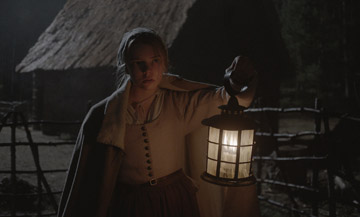|
|
Movie Review: The WitchBy Ben GruchowFebruary 23, 2016
What I’ve just described are events that happen quietly and with some deliberation, and The Witch is light on jump scares or horrific imagery. This is appropriate; the opening title crawl informs us that this is a folktale, and the closing credits tell us that much of the spare dialogue is transcribed from historical record. We reflect on how much a folktale is dependent on preserving its meaning despite being passed down and re-shaped and re-contextualized to fit the culture in which it’s told, and what The Witch has to pass on to us - about what fanaticism can be responsible for, and in a more literal sense the most horrifying type of consequence to pridefulness - is an enduring meaning. A folktale of this type is also primarily concerned with the mythic, and the movie outlines its ominous developments in broad, bold strokes. We do not lack for smaller moments, such as a heartfelt scene between William and his son Caleb (Harvey Scrimshaw) after Samuel’s disappearance, where Caleb asks bluntly about the existence of hell, and whether or not his brother has gone there. But there are fewer and fewer scenes like these as we go on, and there is no humor to relieve us. The people involved in the world of this film have nothing to celebrate and little to be optimistic about. Instead, we continue to watch as crops fail to yield and more family members seem to fall under the influence of a malevolent outside force. I use the word “seem” a lot in this review, and one of the more subtle cues as to the ultimate direction that The Witch is heading in has to do with who’s present in each setup, and who’s not present. Very rarely, after those opening few scenes, do we see everyone in the same place at the same time; without actually giving anything away, this does become germane to the final outcome. Scenes where characters are alone take on the most consequential action, and they’re also responsible for the movie’s moments of isolated, dreamlike horror (a beautifully-executed example of this - a single shot approaching a hut in the woods and revealing its occupant - is as short a jump from storybook illustration to cinema as you’re likely to get in a movie theater in 2016). This is an expertly-rendered story. It’s not a stupendously literate or painstaking character study (except for what we bring to it as audience members, and that’s on us), and it doesn’t need to be; it captures the unique emotions of isolation and repentance and suspicion in a context that’s built for them. The final passages consist of disturbing implications regardless of how you interpret the material. It earns its mood.
|

|
|
|

|
Thursday, October 31, 2024
© 2024 Box Office Prophets, a division of One Of Us, Inc.


